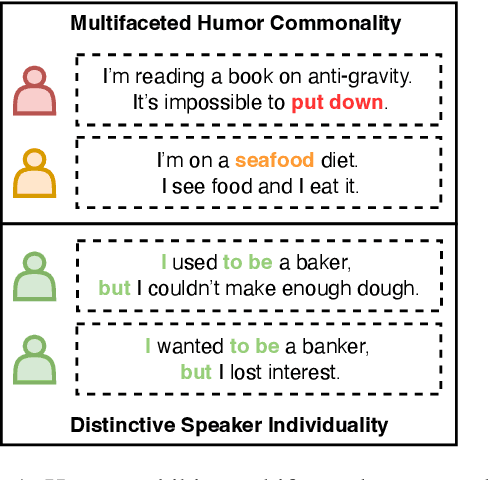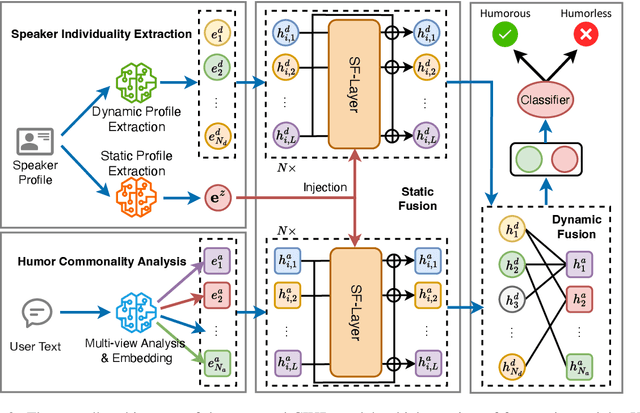Hongfei Lin
MedTrust-RAG: Evidence Verification and Trust Alignment for Biomedical Question Answering
Oct 16, 2025Abstract:Biomedical question answering (QA) requires accurate interpretation of complex medical knowledge. Large language models (LLMs) have shown promising capabilities in this domain, with retrieval-augmented generation (RAG) systems enhancing performance by incorporating external medical literature. However, RAG-based approaches in biomedical QA suffer from hallucinations due to post-retrieval noise and insufficient verification of retrieved evidence, undermining response reliability. We propose MedTrust-Guided Iterative RAG, a framework designed to enhance factual consistency and mitigate hallucinations in medical QA. Our method introduces three key innovations. First, it enforces citation-aware reasoning by requiring all generated content to be explicitly grounded in retrieved medical documents, with structured Negative Knowledge Assertions used when evidence is insufficient. Second, it employs an iterative retrieval-verification process, where a verification agent assesses evidence adequacy and refines queries through Medical Gap Analysis until reliable information is obtained. Third, it integrates the MedTrust-Align Module (MTAM) that combines verified positive examples with hallucination-aware negative samples, leveraging Direct Preference Optimization to reinforce citation-grounded reasoning while penalizing hallucination-prone response patterns. Experiments on MedMCQA, MedQA, and MMLU-Med demonstrate that our approach consistently outperforms competitive baselines across multiple model architectures, achieving the best average accuracy with gains of 2.7% for LLaMA3.1-8B-Instruct and 2.4% for Qwen3-8B.
FocusMed: A Large Language Model-based Framework for Enhancing Medical Question Summarization with Focus Identification
Oct 06, 2025Abstract:With the rapid development of online medical platforms, consumer health questions (CHQs) are inefficient in diagnosis due to redundant information and frequent non-professional terms. The medical question summary (MQS) task aims to transform CHQs into streamlined doctors' frequently asked questions (FAQs), but existing methods still face challenges such as poor identification of question focus and model hallucination. This paper explores the potential of large language models (LLMs) in the MQS task and finds that direct fine-tuning is prone to focus identification bias and generates unfaithful content. To this end, we propose an optimization framework based on core focus guidance. First, a prompt template is designed to drive the LLMs to extract the core focus from the CHQs that is faithful to the original text. Then, a fine-tuning dataset is constructed in combination with the original CHQ-FAQ pairs to improve the ability to identify the focus of the question. Finally, a multi-dimensional quality evaluation and selection mechanism is proposed to comprehensively improve the quality of the summary from multiple dimensions. We conduct comprehensive experiments on two widely-adopted MQS datasets using three established evaluation metrics. The proposed framework achieves state-of-the-art performance across all measures, demonstrating a significant boost in the model's ability to identify critical focus of questions and a notable mitigation of hallucinations. The source codes are freely available at https://github.com/DUT-LiuChao/FocusMed.
CommonVoice-SpeechRE and RPG-MoGe: Advancing Speech Relation Extraction with a New Dataset and Multi-Order Generative Framework
Sep 10, 2025Abstract:Speech Relation Extraction (SpeechRE) aims to extract relation triplets directly from speech. However, existing benchmark datasets rely heavily on synthetic data, lacking sufficient quantity and diversity of real human speech. Moreover, existing models also suffer from rigid single-order generation templates and weak semantic alignment, substantially limiting their performance. To address these challenges, we introduce CommonVoice-SpeechRE, a large-scale dataset comprising nearly 20,000 real-human speech samples from diverse speakers, establishing a new benchmark for SpeechRE research. Furthermore, we propose the Relation Prompt-Guided Multi-Order Generative Ensemble (RPG-MoGe), a novel framework that features: (1) a multi-order triplet generation ensemble strategy, leveraging data diversity through diverse element orders during both training and inference, and (2) CNN-based latent relation prediction heads that generate explicit relation prompts to guide cross-modal alignment and accurate triplet generation. Experiments show our approach outperforms state-of-the-art methods, providing both a benchmark dataset and an effective solution for real-world SpeechRE. The source code and dataset are publicly available at https://github.com/NingJinzhong/SpeechRE_RPG_MoGe.
Cultural Bias Matters: A Cross-Cultural Benchmark Dataset and Sentiment-Enriched Model for Understanding Multimodal Metaphors
Jun 08, 2025Abstract:Metaphors are pervasive in communication, making them crucial for natural language processing (NLP). Previous research on automatic metaphor processing predominantly relies on training data consisting of English samples, which often reflect Western European or North American biases. This cultural skew can lead to an overestimation of model performance and contributions to NLP progress. However, the impact of cultural bias on metaphor processing, particularly in multimodal contexts, remains largely unexplored. To address this gap, we introduce MultiMM, a Multicultural Multimodal Metaphor dataset designed for cross-cultural studies of metaphor in Chinese and English. MultiMM consists of 8,461 text-image advertisement pairs, each accompanied by fine-grained annotations, providing a deeper understanding of multimodal metaphors beyond a single cultural domain. Additionally, we propose Sentiment-Enriched Metaphor Detection (SEMD), a baseline model that integrates sentiment embeddings to enhance metaphor comprehension across cultural backgrounds. Experimental results validate the effectiveness of SEMD on metaphor detection and sentiment analysis tasks. We hope this work increases awareness of cultural bias in NLP research and contributes to the development of fairer and more inclusive language models. Our dataset and code are available at https://github.com/DUTIR-YSQ/MultiMM.
Rethinking Contrastive Learning in Session-based Recommendation
Jun 05, 2025



Abstract:Session-based recommendation aims to predict intents of anonymous users based on limited behaviors. With the ability in alleviating data sparsity, contrastive learning is prevailing in the task. However, we spot that existing contrastive learning based methods still suffer from three obstacles: (1) they overlook item-level sparsity and primarily focus on session-level sparsity; (2) they typically augment sessions using item IDs like crop, mask and reorder, failing to ensure the semantic consistency of augmented views; (3) they treat all positive-negative signals equally, without considering their varying utility. To this end, we propose a novel multi-modal adaptive contrastive learning framework called MACL for session-based recommendation. In MACL, a multi-modal augmentation is devised to generate semantically consistent views at both item and session levels by leveraging item multi-modal features. Besides, we present an adaptive contrastive loss that distinguishes varying contributions of positive-negative signals to improve self-supervised learning. Extensive experiments on three real-world datasets demonstrate the superiority of MACL over state-of-the-art methods.
A Survey on Side Information-driven Session-based Recommendation: From a Data-centric Perspective
May 18, 2025Abstract:Session-based recommendation is gaining increasing attention due to its practical value in predicting the intents of anonymous users based on limited behaviors. Emerging efforts incorporate various side information to alleviate inherent data scarcity issues in this task, leading to impressive performance improvements. The core of side information-driven session-based recommendation is the discovery and utilization of diverse data. In this survey, we provide a comprehensive review of this task from a data-centric perspective. Specifically, this survey commences with a clear formulation of the task. This is followed by a detailed exploration of various benchmarks rich in side information that are pivotal for advancing research in this field. Afterwards, we delve into how different types of side information enhance the task, underscoring data characteristics and utility. Moreover, we discuss the usage of various side information, including data encoding, data injection, and involved techniques. A systematic review of research progress is then presented, with the taxonomy by the types of side information. Finally, we summarize the current limitations and present the future prospects of this vibrant topic.
IPBench: Benchmarking the Knowledge of Large Language Models in Intellectual Property
Apr 22, 2025Abstract:Intellectual Property (IP) is a unique domain that integrates technical and legal knowledge, making it inherently complex and knowledge-intensive. As large language models (LLMs) continue to advance, they show great potential for processing IP tasks, enabling more efficient analysis, understanding, and generation of IP-related content. However, existing datasets and benchmarks either focus narrowly on patents or cover limited aspects of the IP field, lacking alignment with real-world scenarios. To bridge this gap, we introduce the first comprehensive IP task taxonomy and a large, diverse bilingual benchmark, IPBench, covering 8 IP mechanisms and 20 tasks. This benchmark is designed to evaluate LLMs in real-world intellectual property applications, encompassing both understanding and generation. We benchmark 16 LLMs, ranging from general-purpose to domain-specific models, and find that even the best-performing model achieves only 75.8% accuracy, revealing substantial room for improvement. Notably, open-source IP and law-oriented models lag behind closed-source general-purpose models. We publicly release all data and code of IPBench and will continue to update it with additional IP-related tasks to better reflect real-world challenges in the intellectual property domain.
VisualQuest: A Diverse Image Dataset for Evaluating Visual Recognition in LLMs
Mar 25, 2025Abstract:This paper introduces VisualQuest, a novel image dataset designed to assess the ability of large language models (LLMs) to interpret non-traditional, stylized imagery. Unlike conventional photographic benchmarks, VisualQuest challenges models with images that incorporate abstract, symbolic, and metaphorical elements, requiring the integration of domain-specific knowledge and advanced reasoning. The dataset was meticulously curated through multiple stages of filtering, annotation, and standardization to ensure high quality and diversity. Our evaluations using several state-of-the-art multimodal LLMs reveal significant performance variations that underscore the importance of both factual background knowledge and inferential capabilities in visual recognition tasks. VisualQuest thus provides a robust and comprehensive benchmark for advancing research in multimodal reasoning and model architecture design.
Unveiling the Capabilities of Large Language Models in Detecting Offensive Language with Annotation Disagreement
Feb 10, 2025Abstract:LLMs are widely used for offensive language detection due to their advanced capability. However, the challenges posed by human annotation disagreement in real-world datasets remain underexplored. These disagreement samples are difficult to detect due to their ambiguous nature. Additionally, the confidence of LLMs in processing disagreement samples can provide valuable insights into their alignment with human annotators. To address this gap, we systematically evaluate the ability of LLMs to detect offensive language with annotation disagreement. We compare the binary accuracy of multiple LLMs across varying annotation agreement levels and analyze the relationship between LLM confidence and annotation agreement. Furthermore, we investigate the impact of disagreement samples on LLM decision-making during few-shot learning and instruction fine-tuning. Our findings highlight the challenges posed by disagreement samples and offer guidance for improving LLM-based offensive language detection.
Commonality and Individuality! Integrating Humor Commonality with Speaker Individuality for Humor Recognition
Feb 07, 2025



Abstract:Humor recognition aims to identify whether a specific speaker's text is humorous. Current methods for humor recognition mainly suffer from two limitations: (1) they solely focus on one aspect of humor commonalities, ignoring the multifaceted nature of humor; and (2) they typically overlook the critical role of speaker individuality, which is essential for a comprehensive understanding of humor expressions. To bridge these gaps, we introduce the Commonality and Individuality Incorporated Network for Humor Recognition (CIHR), a novel model designed to enhance humor recognition by integrating multifaceted humor commonalities with the distinctive individuality of speakers. The CIHR features a Humor Commonality Analysis module that explores various perspectives of multifaceted humor commonality within user texts, and a Speaker Individuality Extraction module that captures both static and dynamic aspects of a speaker's profile to accurately model their distinctive individuality. Additionally, Static and Dynamic Fusion modules are introduced to effectively incorporate the humor commonality with speaker's individuality in the humor recognition process. Extensive experiments demonstrate the effectiveness of CIHR, underscoring the importance of concurrently addressing both multifaceted humor commonality and distinctive speaker individuality in humor recognition.
 Add to Chrome
Add to Chrome Add to Firefox
Add to Firefox Add to Edge
Add to Edge